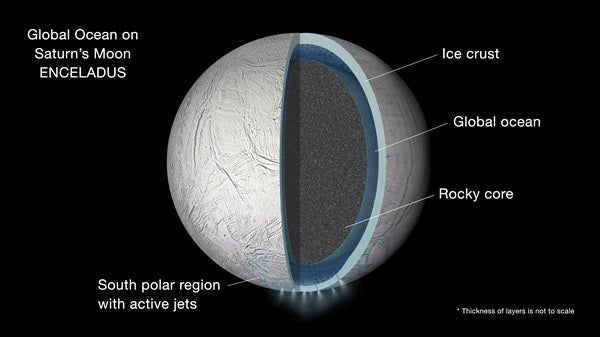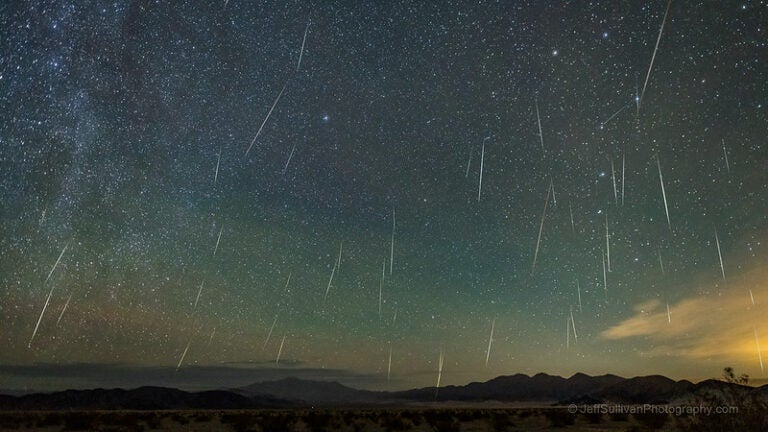Saturn’s moon Enceladus continues to show why it’s one of the best bets in the solar system to search for life. Astronomers have suspected for years that salty water dredged up from a subsurface sea spews into space out of fissures near the moon’s south pole. But an analysis, published online September 11 in the journal Icarus, of seven years of images from NASA’s Cassini spacecraft indicates that Enceladus has a subsurface global ocean instead of merely a regional sea.
Cornell University planetary scientist Peter Thomas and colleagues measured a slight wobble in the moon’s rotation. If Enceladus were solid, its mass would dampen that motion. The researchers believe, instead, that a liquid water ocean lies between the moon’s icy surface layer and the rocky interior. They say the ocean is deeper and the ice shell thinner at the south polar region, where Cassini has spied some 100 geysers of salt water.
Scientists think that to keep any material in liquid state within Enceladus’ interior requires the push-and-pull tidal energy from Saturn. A global ocean is harder to keep warm than a regional sea, and so this discovery could also indicate that the saturnian satellite has more tidal energy than originally thought. “If that is correct,” says team member Carolyn Porco, “and its ocean has been around a long, long time, then it may mean that any life within it has had a long time to evolve.”
Some of the material spewing from Enceladus’ underground ocean flows out through the geysers, flows toward Saturn because of the planet’s gravitational pull, and then orbits the planet as its E ring. In the March 12 issue of Nature, Frank Postberg at the universities of Heidelberg and Stuttgart in Germany and colleagues described how they used the Cassini spacecraft to study some of the material from the E ring. They saw silicon-rich molecules (called silicates) just a few nanometers wide. When this type of material is found in space, it almost always originates from rock being dissolved in water. But to learn the precise characteristics of that water-rock interaction, Postberg’s team collaborated with researchers from Japan to mimic the conditions needed at Enceladus to produce the sizes and composition of silicate particles they observed. They found the water needs to be at least 194° F (90° C) and have a pH between 8.5 and 10.5. These characteristics imply hot-spring-heated water; the only other place where such hydrothermal vents have ever been seen is on Earth, and these sites host extreme organisms.
The chemical reaction that produces the silicates also creates molecular hydrogen, and a different instrument on board Cassini will look for this gas during a late 2015 flight through Enceladus’ plumes. If it detects more molecular hydrogen than expected, it will confirm hydrothermal activity, says Postberg.
This year, astronomers also found the best evidence so far of water at yet another location in our solar system: Jupiter’s large moon Ganymede. NASA’s Galileo spacecraft, which studied the jovian system in the late 1990s and early 2000s, studied Ganymede’s magnetic field to learn whether the moon holds a global ocean under its surface. But the analysis from only 20 minutes of flyby observations was inconclusive. Fast forward to the past year, when Joachim Saur of the University of Cologne and his colleagues studied data from two 7-hour Hubble Space Telescope observations.
Ganymede has an auroral belt in each hemisphere just like Earth does. Jupiter’s magnetic field also influences these aurorae and causes them to rock during Jupiter’s 10-hour rotation period. Saur’s team knew that if Ganymede did not have an ocean, the aurora belts would change their positions slightly, tilting about 6°. “However, when a salty and thus electrically conductive ocean is present, this ocean counterbalances Jupiter’s magnetic influence and thus reduces the rocking of the auroras to only 2°,” says Saur. “We observed Ganymede with the Hubble Space Telescope for more than five hours and saw that the aurora barely moved and rocked by only 2°. This thus confirms the existence of an ocean.” The researchers think the ocean lies about 90 miles (150km) below the moon’s rock-ice crust and is about 60 miles (100km) thick. This strong evidence of Ganymede’s ocean continues to increase the number of worlds in our solar system known to host water.










